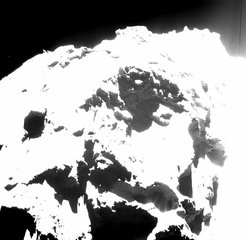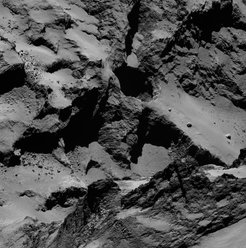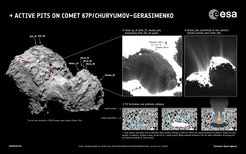Active pits on Rosetta’s comet
Some of the dust jets emitted from Rosetta’s comet can be traced back to active pits on its surface. They could be the remnants of collapsed cavities.
Cavities measuring up to a few hundred meters in diameter can be found under the surface of Rosetta’s comet 67P/Churyumov-Gerasimenko. They can be instable and collapse in a kind of sinkhole process. This is the result of a new study led by researchers from the Max Planck Institute for Solar System Research (MPS) in Germany, which analyses images of the comet’s surface. The images show peculiar, pit-like recesses that are unlike ordinary craters and that emit dust and gas into space. In their study the researchers argue that these pits arise when cavities beneath the surface cave in. The results will be published this Thursday in the journal Nature.

Researchers under the lead of Jean-Baptiste Vincent from the MPS have studied 18 peculiar pit-like depressions all occuring in the northern hemisphere of Rosetta’s comet 67P/Churyumov-Gerasimenko. The scientists analysed images of the comet obtained by OSIRIS, the scientific imaging system on board ESA’s Rosetta spacecraft, in the period from July to December 2014. The pits' diameters vary between ten and a few hundreds of meters. They exhibit nearly vertical sidewalls and are exceptionally deep with the largest ones extending up to two hundred meters into the comet’s interior. The walls of these depressions are characterized by layers and terraces, their bottoms are mostly flat.
Earlier, similar structures had been discovered on the comets 9P/Tempel 1 and 81P/Wild 2, that have been visited by NASA’s space probes Deep Impact and Stardust in the past. “Because of their unusual morphology, these pits can be clearly distinguished from impact craters”, says OSIRIS-scientist Jean-Baptiste Vincent. “They seem to be a typical characteristic of comets”, he adds.
Some of the pits are also active: fine jets of dust are emitted from the inside walls. The scientists reached this conclusion by studying images showing the same jet from different perspectives. “In this way we obtain information on the jet’s three dimensional structure and can determine their origin on the surface”, says Vincent.

However, the emission of dust alone cannot have created these structures. Frozen gases evaporating from the comet’s surface under the influence of the Sun cannot carry enough dust with them to create holes of this size. In some cases, thousands of years of evaporation would be necessary. However, Rosetta’s comet has been advancing into the inner solar system and therewith into the Sun’s vicinity only since 1959. And even a sudden outburst of activity like the one Rosetta witnessed during the approach phase in April 2014 is unable to move enough material.
Instead, it is most likely that the pits are collapsed cavities. “Apparently, these underground voids grow larger with time until the top layer becomes instable and caves in," says Holger Sierks from the MPS, co-author of the new paper and OSIRIS Principal Investigator. As a result, fresh material is exposed at the edges of the depression. From there gases can vaporise thus charging the observed jets.
But how did the cavities come to be? The researchers currently see several possibilities. For example, the voids could date from the comet’s birth. When smaller chunks, called planetesimals, collide at low speeds such gaps may remain.
It is also conceivable, that frozen carbon dioxide and monoxide evaporating from deep within the cometary nucleus produce such subsurface structures. Frozen water evaporates at much higher temperatures. It is difficult to achieve these temperatures beneath the comet's highly insulating, superficial layer of dust by solar radiation alone. Instead, the researchers have a different heat source in view. When amorphous ice beneath the comet's surface consisting of irregularly packed molecules transforms into crystallized ice, heat is released. This might suffice to evaporate water in sufficient quantities.
"At this point, we do not favour any of these three options. Maybe even all effects work together”, says Sierks. "But we hope that the mission will brings clarity in its further course."
Already, the active pits prove useful for estimating the age of cometary surfaces. "Since the pits are active, they change with time," says Vincent. By and by the pits expand: the edges retreat forming extensive terraces. A cometary surface exhibiting deep holes is therefore rather young. Older areas present themselves as smooth plateaus.

Rosetta is an ESA mission with contributions from its member states and NASA. Rosetta's Philae lander is provided by a consortium led by DLR, MPS, CNES and ASI. Rosetta is the first mission in history to rendezvous with a comet, escort it as it orbits the Sun, and deploy a lander to its surface.
The scientific imaging system OSIRIS was built by a consortium led by the Max Planck Institute for Solar System Research (Germany) in collaboration with CISAS, University of Padova (Italy), the Laboratoire d'Astrophysique de Marseille (France), the Instituto de Astrofísica de Andalucia, CSIC (Spain), the Scientific Support Office of the European Space Agency (The Netherlands), the Instituto Nacional de Técnica Aeroespacial (Spain), the Universidad Politéchnica de Madrid (Spain), the Department of Physics and Astronomy of Uppsala University (Sweden), and the Institute of Computer and Network Engineering of the TU Braunschweig (Germany). OSIRIS was financially supported by the national funding agencies of Germany (DLR), France (CNES), Italy (ASI), Spain (MEC), and Sweden (SNSB) and the ESA Technical Directorate.


